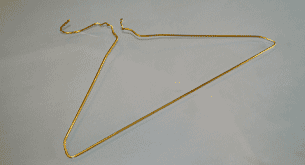6
DifficultyElectronic Buzzer Game
Posted by Admin / in Science Games
Teach kids to build a fun electronic buzzer game, then play the game for a fun activity.
Materials Needed
- Wire (2 small sections)
- Wide rubber band
- Small paper fasteners
- Buzzer (3 volt DC) - Radio Shack Part No. 273-053A
- - or Amico Electronic Buzzer -
- LED (red)
- 56 Ohm (1/8 W or 1/4 W) resistor
- 2 AA batteries
- Metal coat hanger
- Tool to cut metal coat hanger
- Clay or small wood blocks
EXPERIMENT STEPS
Step 1. Have an adult cut and remove the coat hanger hook using angle pliers, combination pliers or tin snips.

Have an adult help to get wire from a coat hanger.
Step 2. Bend the metal hanger wire in different directions to create a challenging path to follow. Make sure there is a gap left in the path of the hager wire of a minimum of 1 inch.
Step 3. Make two balls of clay large enough to anchor the coat hanger wire. This will help the coat hanger stand up during game play. Optionally, two small wood blocks will also work. Drill a small hole slightly smaller than the diameter of the coat hanger wire into the center of each block, then push one end of the coat hanger wire into each block.
Step 4. Push two paper fasteners at each side of a rubber band. Position the studs of the metal fasteners on the inside of the rubber band with the legs on the outside.
Step 5. Wrap the rubber band embedded with paper fasteners around two AA batteries placed end to end. Wrap tape around the center of the two batteries to provide support and help keep them connected.
Step 6. Have two pieces of electrical wire ready. One piece should be about 6 inches long and the other about 2 feet long. Strip a long section of wire coating off each side of both pieces of electrical wire. Strip off at least an inch of bare wire off each end to make connections easier. On one side of the 2 foot piece of wire strip off about 2 inches of wire coating.
Step 7: Attach the negative (-) lead from the battery to the positive (+) lead of the buzzer. The Radio Shack and Amico buzzers both have built-in wires. If you are using another type of buzzer without wire, then additional wire pieces will be needed to make the connections.
Step 8: Attach the negative (-) lead of the buzzer to the positive (+) lead of the resistor.
Step 9: Attach the negative (-) lead of the resistor to the positive (+) lead of the red LED.
Step 10: Attach the negative (-) lead of the LED to the one side of the 6 inch piece of electrical wire.
Step 11: Attach the other side of the electrical wire to one leg of the coat hanger wire.
Step 12: Make a loop on the longer, two inch section of stripped wire on the 2 foot wire section. Make the loop large enough to easily fit around the coat hanger wire, but not too big.
Step 13: Connect the other end of the 2 foot wire section to the negative (-) paper fastener side of the battery holder.
Step 14: Attach the clay balls (or wood blocks) to each end of the wire hanger so the wire stands up.

Use clay balls or wood to support the wire.
How the game is played:
Game players start at one side of the coat hanger wire obstacle. They maneuver the wire loop along the hanger wire until they reach the other side without completing the circuit. If the wire loop touches the hanger, the circuit is closed and the buzzer will sound the the LED will light up. If there are groups of kids more than one game could be made, then the teams could race each other one at a time. If a team member touches the side and sounds the buzzer, they must start over. If only one game is made, time how long it takes for each player to successfully finish without sounding the buzzer. The winner is the one who can complete the game in the lowest amount of time.
To make the game more challenging, make the loop of wire smaller. Also, try bending the coat hanger wire more to add more difficulty.
This electronic game gives kids the insight on how simple games are made. They can create a simple electrical circuit that has immediate results from a LED lamp and a buzzer. They can also have fun. This electronic buzzer game is a great project for a science fair, science class, circuits class, or summer science camp. Teams of kid scientists can put together the simple circuit game and race for fun with surprising little instruction.
